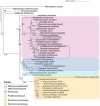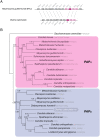Genome analysis of the yeast Diutina catenulata, a member of the Debaryomycetaceae/Metschnikowiaceae (CTG-Ser) clade
- PMID: 29944657
- PMCID: PMC6019693
- DOI: 10.1371/journal.pone.0198957
Genome analysis of the yeast Diutina catenulata, a member of the Debaryomycetaceae/Metschnikowiaceae (CTG-Ser) clade
Abstract
Diutina catenulata (Candida catenulata) is an ascomycetous yeast that has been isolated from humans, animals and environmental sources. The species is a contaminant of dairy products, and has been linked to superficial and invasive infections in both humans and animals. Previous phylogenetic analyses have assigned the species to the Saccharomycetales, but failed to identify its specific clade. Here, we report the genome sequence of an environmental isolate of D. catenulata. Examination of the tRNA repertoire and coding potential of this species shows that it translates the CUG codon as serine and not leucine. In addition, two phylogenetic analyses using 204 ubiquitous gene family alignments and 3,826 single-copy genes both confirm the placement of the species in the Debaryomycetaceae/Metschnikowiaceae, or CTG-Ser clade. The sequenced isolate contains an MTLα idiomorph. However, unlike most MTL loci in related species, poly (A) polymerase (PAP) is not adjacent to MTLα1.
Conflict of interest statement
The authors have declared that no competing interests exist.
Figures



Similar articles
-
Comparative evolutionary genomics unveils the molecular mechanism of reassignment of the CTG codon in Candida spp.Genome Res. 2003 Apr;13(4):544-57. doi: 10.1101/gr.811003. Genome Res. 2003. PMID: 12670996 Free PMC article.
-
Characterization of serine and leucine tRNAs in an asporogenic yeast Candida cylindracea and evolutionary implications of genes for tRNA(Ser)CAG responsible for translation of a non-universal genetic code.Nucleic Acids Res. 1994 Jan 25;22(2):115-23. doi: 10.1093/nar/22.2.115. Nucleic Acids Res. 1994. PMID: 8121794 Free PMC article.
-
Description of Diutina gen. nov., Diutina siamensis, f.a. sp. nov., and reassignment of Candida catenulata, Candida mesorugosa, Candida neorugosa, Candida pseudorugosa, Candida ranongensis, Candida rugosa and Candida scorzettiae to the genus Diutina.Int J Syst Evol Microbiol. 2015 Dec;65(12):4701-4709. doi: 10.1099/ijsem.0.000634. Epub 2015 Sep 25. Int J Syst Evol Microbiol. 2015. PMID: 26410375
-
The non-standard genetic code of Candida spp.: an evolving genetic code or a novel mechanism for adaptation?Mol Microbiol. 1997 Nov;26(3):423-31. doi: 10.1046/j.1365-2958.1997.5891961.x. Mol Microbiol. 1997. PMID: 9402014 Review.
-
Deus ex Candida genetics: overcoming the hurdles for the development of a molecular toolbox in the CTG clade.Microbiology (Reading). 2012 Mar;158(Pt 3):585-600. doi: 10.1099/mic.0.055244-0. Epub 2012 Jan 27. Microbiology (Reading). 2012. PMID: 22282522 Review.
Cited by
-
Diversity and Antifungal Susceptibilities of Yeasts from Mangroves in Hong Kong, China-A One Health Aspect.J Fungi (Basel). 2024 Oct 20;10(10):728. doi: 10.3390/jof10100728. J Fungi (Basel). 2024. PMID: 39452680 Free PMC article.
-
Candida haemulonii species complex: emerging fungal pathogens of the Metschnikowiaceae clade.Zoonoses. 2023 Jan 3;3(1):43. doi: 10.15212/zoonoses-2023-0021. Epub 2023 Oct 31. Zoonoses. 2023. PMID: 39238892 Free PMC article.
-
Bacteriome and mycobiome profiling of liquid feed for finisher pigs on commercial pig farms.Sci Rep. 2025 Jul 9;15(1):24718. doi: 10.1038/s41598-025-05928-8. Sci Rep. 2025. PMID: 40634391 Free PMC article.
-
Snakes and Souks: Zoonotic pathogens associated to reptiles in the Marrakech markets, Morocco.PLoS Negl Trop Dis. 2023 Jul 19;17(7):e0011431. doi: 10.1371/journal.pntd.0011431. eCollection 2023 Jul. PLoS Negl Trop Dis. 2023. PMID: 37467211 Free PMC article.
-
Oral swabs as a proxy for direct ruminal microbiome sampling in Holstein dairy cows is correlated with sample color.Front Microbiol. 2024 Sep 17;15:1466375. doi: 10.3389/fmicb.2024.1466375. eCollection 2024. Front Microbiol. 2024. PMID: 39355424 Free PMC article.
References
-
- Delavenne E, Mounier J, Asmani K, Jany JL, Barbier G, Le Blay G (2011) Fungal diversity in cow, goat and ewe milk. Int J Food Microbiol 151: 247–251. doi: 10.1016/j.ijfoodmicro.2011.08.029 - DOI - PubMed
-
- Gkatzionis K, Yunita D, Linforth RS, Dickinson M, Dodd CE (2014) Diversity and activities of yeasts from different parts of a Stilton cheese. Int J Food Microbiol 177: 109–116. doi: 10.1016/j.ijfoodmicro.2014.02.016 - DOI - PubMed
-
- Cogan TM, Goerges S, Gelsomino R, Larpin S, Hohenegger M, Bora N, et al. (2014) Biodiversity of the surface microbial consortia from Limburger, Reblochon, Livarot, Tilsit, and Gubbeen cheeses. Microbiol Spectr 2: CM-0010-2012. - PubMed
-
- Santin R, Mattei AS, Waller SB, Madrid IM, Cleff MB, Xavier MO, et al. (2013) Clinical and mycological analysis of dog’s oral cavity. Braz J Microbiol 44: 139–143. doi: 10.1590/S1517-83822013005000018 - DOI - PMC - PubMed
Publication types
MeSH terms
Substances
Grants and funding
LinkOut - more resources
Full Text Sources
Other Literature Sources
Molecular Biology Databases
Research Materials

